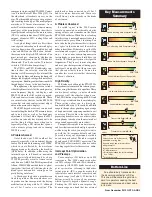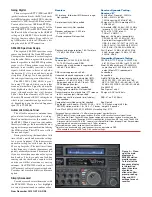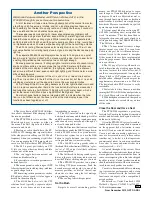
From December 2010 QST © ARRL
Another Perspective
Well-known Delaware contester and DXer Jon Zaimes, AA1K, ran the
FT
DX
5000 through its paces. Here are his observations.
A lot of features will take a more thorough absorption of the manual to master;
a few things didn’t seem very intuitive, and I’m a longtime previous Yaesu user.
But it certainly has the feel of a quality radio, and I really like the way it sounds! It
has a quiet band floor and handles noise very well.
The receiver seems nice and tight. I never encountered any problems with
overload while tuning across the band, even with the 20 meter Yagi stack aimed
toward Europe and many strong signals. While transmitting on a separate radio
on 1820.6 kHz with 1.5 kW and with no extra band-pass filters in line, I could hear
no
interference across 20 meters while beaming right at the transmitting antenna.
The 300 Hz roofing filter really makes for nice tight skirts on
CW
. The
APF
also
was very effective for isolating really close-in signals, making the desired one pop
right up.
The separate SM-5000 band display makes it easy to find signals on a quiet
band. A way to “point and shoot” with a mouse would be nice. Also, I never found
a setting that yielded optimal contrast yet was still bright enough.
Some ergonomic concerns: If sitting upright at normal distance to reach tuning
knob and other controls, one cannot see the top of the S meter and the top row
of labels of the main display. In addition, the light-gray lettering on the charcoal
panel is
very
difficult to read, even under bright lighting, and this made for a more
difficult learning curve.
I found the relative placement of the
VFO A
and
VFO B AF GAIN
controls confus-
ing. The
VFO B
control is to the left of the
VFO A AF GAIN
control, but the
VFO A
and
B
subdisplay clusters are just the opposite. For me this was counterintuitive.
At first I thought the
ATU
was going bonkers as the dial lights flashed
HI SWR
and
TUNE
in rapid succession after I held in the
TUNE
button. But after a few seconds it
had tuned the radio to a flat SWR on 7295 kHz with my 40 meter beam, which is
cut for the low end of CW and has a high SWR at the high end.
Nice!
Some front-panel buttons have an integrated LED to indicate when the func-
tion is on, but others do not. You have to look at the main display to see if the
function has been toggled on or off.
The very effective DSP
CONTOUR
fea-
ture allows additional filter shaping within
the receive passband.
The FT
DX
5000 has two notches. The
IF notch can be set to narrow or wide via
the menu. The
DNF
(digital notch filter) is
automatic and fixed.
Everyone’s radio should have the FT-
DX
5000’s CW tuning guide, especially those
folks who persist in calling you 300 Hz off
frequency when you’re running a tight filter.
You can repurpose the CW tuning guide to
serve as a
CLAR
(clarifier or RIT) offset bar.
The
APF
is great, particularly on CW.
It lets you tease otherwise barely audible
stations out of the noise.
You can toggle between narrow and
wide noise blanker settings.
It’s possible to set certain parameters to
be band-specific.
The menu permits a wide range of DSP
filter customization, including steep, medium
or gentle shape factors.
When setting certain parameters, such as
RF output or keyer speed, its value appears
briefly on the main display.
The
MONI
knob also sets the CW
sidetone level, typically a separate adjust-
ment on lesser transceivers (and some-
times hidden in a menu).
The
VRF
, inserted in the signal path
between the antenna and the band-pass filter
and RF amplifier, is handy to enhance noise
reduction on a very noisy band, although it’s
not really intended for that.
The
NAR
(narrow) button is an excellent
feature that expands the
WIDTH
range down-
ward to 500 Hz or less for a given receiver.
This two-tier system lets you use the
NAR
button to toggle between one very narrow
setting and one not-so-narrow setting.
The
CLASS A
setting greatly reduces
third and fifth-order transmit IMD (ie, “splat-
ter”) at a 75 W output level that’s sufficient
for most amplifiers.
The full break-in keying sounds great,
but as is the case with many radios you can
hear the TR relay clicking along as you send.
The FT
DX
5000 provides two options
for filling CW keyer memories: Send the
desired message and record it in one of the
memory positions, or “dial in” the text, one
character at a time, using the text message
programming setting.
The cooling fan is whisper quiet.
Not So Much
Despite its overall outstanding perfor-
mance, our FT
DX
5000 did not
quite
repre-
sent the apex of Amateur Radio transceiver
enterprise. Yaesu has addressed several is-
sues through firmware updates or hardware
modifications, but others are simply design
drawbacks. Here are some kinks we spotted,
again in no particular order.
A front panel label on earlier-run FT-
DX
5000s (including ours) misspelled the
word “transceiver.” This has been fixed in
later production runs, and some already are
calling units bearing the
TRANCEIVER
label
“The Collectors’ Edition.”
The 176 item menu system is a huge
improvement over what I’ve seen from
Yaesu in the past, but it still mandates oc-
casional visits to the manual to decipher.
Other manufacturers have implemented
plain language menus; Yaesu is behind the
curve on this one.
The 144 page
Operating Manual
has a
lot of information about setting up and using
the many features this radio offers, but it
could use some improvement. Among other
things it lacks a CAT reference as well as a
detailed index, although Yaesu does provide
supplementary information on its Web site.
The downloadable PDF version is easily
searchable.
I detected a low level hum or tone when
turning the VFO A
AF GAIN
control past about
12 o’clock. Yaesu said it would look into this.
With headphones connected, the speaker
comes on for about a second when you turn
off the radio.
Close the Door and Have a Seat
The FT
DX
5000 represents a giant leap
forward for Yaesu in the high end transceiver
market, and it already has begun to attract an
enthusiastic following.
Given the FT
DX
5000’s price class and in-
tended market, we are compelled to comment
on the apparent lack of attention to some
details. [Of course as noted in other reviews,
Yaesu is not alone in making updates as is-
sues are discovered in early release radios.
Another way to look at it is that in previous
generations of radios, fixes to major problems
were slow to come and minor issues were
rarely resolved. —
Ed
.]
As noted throughout the review, Yaesu
has addressed reported issues through firm-
ware updates or hardware modifications (in
some cases requiring the radio to be shipped
back for service). Current production radios
should not exhibit many of the issues encoun-
tered in our early production model.
Yaesu is to be commended for combining
top tier receiver performance and a clean
Class A transmitter with the features and
functions users expect, all in a competitively
priced package.
Manufacturer:
Vertex Standard, 10900
Walker St, Cypress, CA 90630; tel 714-827-
7600;
www.yaesu.com
.
























